Annotation:G Rag
Back to G Rag
G RAG. AKA and see "Bust Down Stomp," "Concord Rag," "Y.Z. Special," "Hamilton's Special Breakdown." American, Country Rag (cut time). USA; Alabama, North Georgia. G Major. Standard tuning (fiddle). AABB. "'G' Rag" has been called "A Georgia standard." This ragtime influenced tune was recorded by Afro-Cherokee fiddler Andrew Baxter with the Ga. Yellow Hammers [1] in 1927, and by fellow Georgia fiddler Earl Johnson in 1928. North Georgia fiddler Gid Tanner also knew the tune, and his son Gordon used it as the theme song for his band the Junior Skillet Lickers. North Carolina fiddler J.E. Mainer covered it under the title "Concord Rag", titling it for the North Carolina town he moved to for work in a mill. Charles Wolfe (1979) says the tune possibly originated with an Alabama fiddler named Wyzee Hamilton, who recorded a version called "Hamilton's Special Breakdown."

. The tune features imitation train sounds in the two parts following the melodic first strain, enhanced on the Georgia Yellow Hammers' recording by vocalized "conductor's calls". Andrew Baxter (1869-1955) and his son Jim (1898-1950, guitar) had been booked for the same session for Victor Records as the Georgia Yellow Hammers, in Charlotte, North Carolina, in August, 1927 (although they had to ride separately to the session in segregated train cars). They were recorded in separate sessions but for "G Rag" only Baxter joined the white group to play fiddle, one of the earliest instances of an integrated recording session with Georgia musicians.

The Georgia Yellow Hammers were reportedly given their name at an earlier recording session in Atlanta in Febuary 1927. Yellow Hammers singer, banjo and fiddle player Bud Landress recalled that a technician for the record company thought up the name “The Georgia Yellow Hammers," probably after the distinctive member of the woodpecker family, the Northern Flicker, also called the Yellowhammer. Since 1927 it has been the state bird of Alabama. Soldiers from Alabama were nicknamed “yellowhammers” in the Civil War due to their grey-and-yellow uniforms, which matched the colors of the bird. However, the name Yellowhammer has also been used as a pejorative term for migrants, hill folk, and homeless people, and has a particularly sexualized derogatory meaning, denoting incest and inbreeding. The term began in Wilmington, Illinois, after the Civil War when an influx of people moved in to try to take advantage of work in the Peabody coal fields. As no housing resources were available, a tent city grew up on land purchased by an ex-Confederate officer, Colonel Brodie, who had been a prisoner during the Civil War. After the war Brodie stayed on in the North and invited friends and relations from Alabama; soon there were flocks of displaced people squatting on his land. From this, a shanty town developed. The name 'yellowhammer' to denote people from the shanty town may have developed from association with Brodie's Alabama roots, or from the color of the handles of the tools used in the mines. Since tools were expensive, the story goes, they were shared among shifts and remained in the mines; the handles were painted yellow so they could be identified when needed. From local Wilmington use, the pejorative term spread and has been used as a general term, synonymous with 'white trash'.
Source for notated version:
Printed sources:
Recorded sources: Heritage 048, Gordon Tanner - "Georgia Fiddle Bands" (Brandywine 1982). Rounder 1032, The Georgia Yellow Hammers - "The Moonshine Hollow Band" (1979).
See also listing at:
Hear Andrew Baxter and the Georgia Yellow Hammers recording at Slippery Hill [2] and at youtube.com [3]
